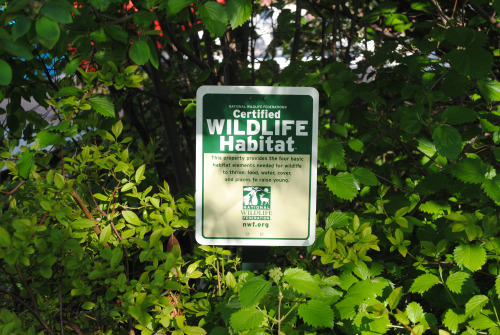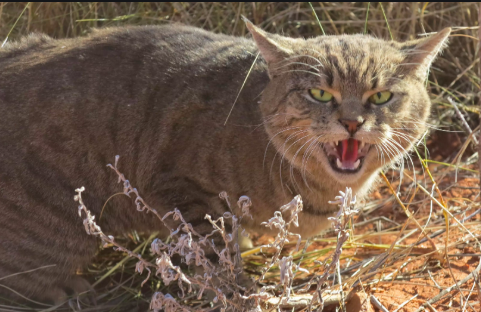
West Hollywood, whose residents in the past have complained about the presence of coyotes and raccoons in their neighborhoods, now will be asked to give at least some types of wildlife a welcome.
The West Hollywood City Council on Monday night agreed to identify areas in WeHo that can be designated as “certified wildlife habitats.” It also agreed to a plan that would allow the trapping, neutering, and return of feral cats, which the city now will begin calling “community cats.”
The Council’s decision on wildlife habitats came on a proposal by Councilmember Lauren Meister and Mayor John D’Amico that would have City Hall staffers look into the possibility of creating wildlife habitats in public locations like Kings Road Park, Hart Park, Havenhurst Park, or Formosa Park – areas chosen because they aren’t heavily used. The proposal also would promote the idea of local residents creating wildlife habitats on their property.
A certified wildlife habitat is “a combination of food, water, shelter, and space arranged to meet the needs of wildlife,” says a memo to the Council. “Even a small yard can be landscaped to attract birds, butterflies, beneficial insects, and small animals. Trees, shrubs, and other plants provide shelter and food for wildlife.
“Human activity has changed and eliminated habitat, locally, and on the global scale, and birds, butterflies, and other wildlife are pushed into ever-shrinking wilderness areas. Rapid and large-scale changes to our lands and waters mean wildlife are losing the habitats they once knew. Every habitat garden is a step toward replenishing resources for wildlife such as bees, butterflies, birds, and amphibians — both locally and along migratory corridors.”
The certified wildlife habitat program has been established by the National Wildlife Federation. Those who apply for certification must confirm that they have planted native species that will provide seeds, berries, nuts, nectar, fruit, sap, and pollen for wildlife. They also must add feeders for birds, squirrels, hummingbirds, and butterflies.
There also must be at least one source of water for drinking, bathing, and reproduction. It can be a natural source like a stream or a manmade source like a birdbath.
The certified habitats have to provide shelter for animals and insects that inhabit them. That can include trees and dense shrubs for insects and small animals and houses for specific birds, bats, and bees. NWF certification requires two shelter areas. And the habitats have to be suitable places for young wildlife to grow and thrive.
Finally, the NWF requires that those seeking certification manage the habitat in an organic and environmentally friendly way by reducing water use, eliminating exotic plants and avoiding the use of chemicals. NWF certification costs $20 and the application process can be found online.
Community (aka Feral) Cats

The “community cat” initiative would establish what’s called a “trap-neuter-return” program. Cats currently deemed to be “feral” are those that have been born in the wild or have reverted to a wild state and are not domesticated or tamed. Such cats can remain on private property and only be removed if someone submits a written complaint explaining what problems the cat community is causing.
The new TNR program allows a property owner to obtain a city permit at no charge to trap a “community” cat if that is done in a humane way, using drop traps or box traps. Leg-hold traps or darts and tranquilizers are not permitted. The property owner then must take the cat to a nonprofit organization such as FixNation or Luxe Paws to have the cat neutered. Kittens or recently abandoned or lost cats can be put up for adoption. Older cats that are unsuitable for adoption must be returned to the area where they were trapped. The property owner must alert everyone living within 150 feet of the cat’s location to ensure that it isn’t actually the personal property of a neighbor.
A memo to the Council from the Department of Public Works advises against openly feeding community cats. It notes that large quantities of food left outside for cats can attract other animals such as mice, rats, squirrel, raccoons, and coyotes. And it notes that “community cats can take care of themselves,” when it comes to food. “They hunt and eat a variety of smaller animals. including, mice, rats, birds, snakes, and lizards.”
However, a property owner with a TNR permit can provide a feeding station for a returned cat or cats that must be enclosed by a fence or other barrier that is at least six feet high to keep other animals for getting access to the food.
Currently, Los Angeles County bars an individual from possessing more than five cats. The new city regulation would exempt community cats from that count.

Calling them “community cats” unfortunately, does nothing to reduce the total decimation of smaller sized native animals that are a vital part of the wildlife that the city purports to support. Cats are highly effective predators and every small bird, their nestlings, fence lizards and others, all suffer as a result. The science is irrefutable and the studies have been replicated many times. Cats are lovely indoor companions but to allow them outdoor freedom at any time is irresponsible and to encourage a feral state is incredibly so. You cannot honestly claim to support wildlife and also encourage feral cats.
Years ago I bought a house from a couple who, unknown to me, fed feral cats. I had 15 to twenty cats hanging out at my place for quite a long time and I never once fed any of them.
I was not pleased!
Feral house cats are hell on the environment and everyone. They should be culled/euthanized
House cats (Felis catus)are not wildlife, not in America and not in their homeland of north Africa–Middle East. They are an entirely domesticated species, even though some of them lack owners. Treating them like wildlife is a perversion of logic. If some cats are unowned, then the people who feed them, or otherwise call themselves cat caretakers, should relocate them to enclosed private property, and treat them with the kindness that people who love cats treat their owned cats. The fact that some outdoor unowned cats are not affectionate to people does not prevent them from being kept enclosed. They… Read more »
There are an estimated 50- 70 million free-roaming cats that aren’t owned in the US alone. How would anyone get all those cats enclosed after TNR? Who is going to pay for that? Colony caretakers are all volunteers who love cats and spend their time and money on these cats, but having an enclosure is a whole different ballgame that they can’t afford. Two, you have obviously never relocated feral and semi-feral cats. They usually do not stay without months of acclimation (it is still iffy whether they stay too) and will try to go back to their ‘home’ which… Read more »
Wildlife in West Hollywood? Try Santa Monica Boulevard.
What an outrage. “Certification” of wildlife habitat is now defined as deliberately protecting and proliferating invasive, reflex-killing domestic felines and their more than 50 zoonotic diseases to the detriment of public health and naturally-occurring biodoversity (what little is left)??? This is insanity.
Sunday morning I stepped out of my kitchen door to the former driveway area we now use as a play area for our grandchildren. At first glance I thought I was seeing a shadow near my feet. Second, more intense glance brought into focus a male red squirrel – one I have come to know quite well. He then accompanied me as I walked further into the back yard. His brazen behavior was the result of my allowing him to scoop up the sunflower seeds from the bird feeders without any distraction. But, it’s not only the sunflower seeds he… Read more »
People who proliferate invasive species are not “guardians of nature”–urban, or any other kind.
How very sweet